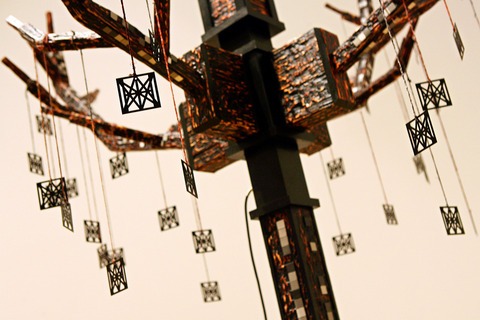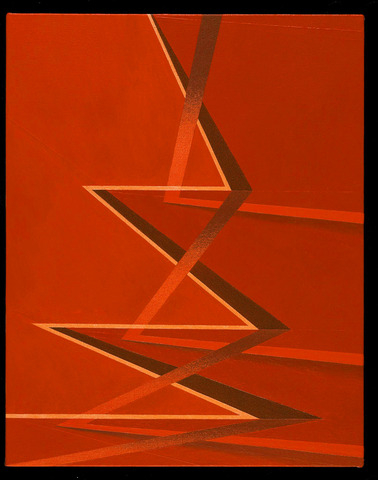There are no flashing lights this year, literally or metaphorically; no scandal, manufactured or otherwise, in the form of elephant dung or pornographic pots. This year's Turner prize has been won by the deeply serious abstract painter Tomma Abts — the first woman to win since Gillian Wearing took the prize in 1997, and the first artist devoted to painting since Chris Ofili in 1998.
Abts was awarded the ?25,000 (NT$1.6 million) prize Monday night by Yoko Ono at a ceremony at Tate Britain in London. She proved a hugely popular winner among the British art world — which was out in force last night at what amounts to its annual tribal get-together.
Since 1998, all the paintings by this German-born, London-based artist have been made on canvases measuring precisely 48cm x 38cm. She uses no source material, but allows the form of the paintings to emerge as she applies layers of color — a process that mingles disciplined severity with pure intuition. The results are entirely sui generis — some of the forms look as if they want to struggle into three dimensions; others coil, snakelike, across the canvas.

PHOTOS: AFP AND AP
Abts saw off opposition from three other shortlisted artists, each of whom wins ?4,000. Phil Collins' submission was based around the making of a film called The Return of the Real, in which he gave people whose lives had been ruined by reality TV an opportunity to tell their stories, unedited. Rebecca Warren is a sculptor whose often highly sexualized work takes on artists such as Rodin and Giacometti. Mark Titchner creates installations, posters and billboards that question belief systems, from religion to science.
For the seventh year running, the group of anti-Tate, anti-Turner prize artists known as the Stuckists picketed Tate Britain as guests filtered into the gallery for the ceremony. Formerly dismissed as cranks, the Stuckists (so known because Tracey Emin once accused her then boyfriend, former Stuckist Billy Childish, of being "stuck") this year precipitated a Charity Commission report into conflict of interest on the Tate board of trustees.
The group had campaigned against the Tate's purchase of Ofili's ?600,000 installation, The Upper Room, while Ofili was a serving trustee. When the Charity Commission reported on the affair this summer, it reprimanded the Tate for mismanaging conflict of interest and expressed disappointment that better standards had not been met.

Last night, the Stuckists called for the resignation of the Tate's director, Nicholas Serota, and its chairman, Paul Myners.
They also brandished placards asking "Is it all a fix?" quoting a piece by Lynn Barber, a writer for the Observer and a Turner prize juror this year.
Breaking the traditional omerta observed by jurors, she wrote an article in October that has overshadowed the latter stages of this year's prize. In it, she aired her bafflement at the judging process, and declared her enthusiasm for contemporary art "seriously dampened" after her year as a Turner panel member.
She described feeling "demoralized, disillusioned, and full of dark fears that I have been stitched up — that actually the art world [whatever that is] has already decided who will win the 2006 Turner prize and that I am brought in purely as a figleaf."
Charles Thomson, leader of the Stuckists, yesterday described Abts' work as "silly little meaningless diagrams that make 1950s wallpaper look profound." The runners-up came in for equal disdain. He advised Phil Collins to "get out more"; Mark Titchner prompted him to ask "What is this load of rubbish doing in the Tate?" and, he added, "Rebecca Warren makes Mr. Blobby look like Michelangelo."
The Turner prize awards a British-based or British-born artist under 50 for an outstanding exhibition of his or her work in the 12 months preceding May 9, 2006.
The other jurors were Margot Heller, director of the South London gallery; Matthew Higgs, director of the White Columns gallery in New York; Andrew Renton, director of the curators' course at Goldsmiths College; and Nicholas Serota, chairman of the jury.
Since its inception in 1984, previous winners have included Howard Hodgkin (1985), Damien Hirst (1995), Martin Creed (2001), and, last year, Simon Starling.

May 11 to May 18 The original Taichung Railway Station was long thought to have been completely razed. Opening on May 15, 1905, the one-story wooden structure soon outgrew its purpose and was replaced in 1917 by a grandiose, Western-style station. During construction on the third-generation station in 2017, workers discovered the service pit for the original station’s locomotive depot. A year later, a small wooden building on site was determined by historians to be the first stationmaster’s office, built around 1908. With these findings, the Taichung Railway Station Cultural Park now boasts that it has

The latest Formosa poll released at the end of last month shows confidence in President William Lai (賴清德) plunged 8.1 percent, while satisfaction with the Lai administration fared worse with a drop of 8.5 percent. Those lacking confidence in Lai jumped by 6 percent and dissatisfaction in his administration spiked up 6.7 percent. Confidence in Lai is still strong at 48.6 percent, compared to 43 percent lacking confidence — but this is his worst result overall since he took office. For the first time, dissatisfaction with his administration surpassed satisfaction, 47.3 to 47.1 percent. Though statistically a tie, for most

Wooden houses wedged between concrete, crumbling brick facades with roofs gaping to the sky, and tiled art deco buildings down narrow alleyways: Taichung Central District’s (中區) aging architecture reveals both the allure and reality of the old downtown. From Indigenous settlement to capital under Qing Dynasty rule through to Japanese colonization, Taichung’s Central District holds a long and layered history. The bygone beauty of its streets once earned it the nickname “Little Kyoto.” Since the late eighties, however, the shifting of economic and government centers westward signaled a gradual decline in the area’s evolving fortunes. With the regeneration of the once

In February of this year the Taipei Times reported on the visit of Lienchiang County Commissioner Wang Chung-ming (王忠銘) of the Chinese Nationalist Party (KMT) and a delegation to a lantern festival in Fuzhou’s Mawei District in Fujian Province. “Today, Mawei and Matsu jointly marked the lantern festival,” Wang was quoted as saying, adding that both sides “being of one people,” is a cause for joy. Wang was passing around a common claim of officials of the People’s Republic of China (PRC) and the PRC’s allies and supporters in Taiwan — KMT and the Taiwan People’s Party — and elsewhere: Taiwan and